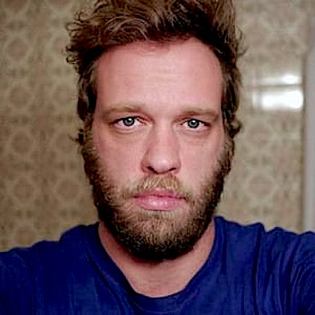Photographers Unknown, You Draw Your Own Breath, Then I Draw Mine
Underneath your skin, your heart
moves. Your chest
rises at its touch. A small bump
appears, every
second. We watch for what appears
to be hours.
Our hands log the time: the soft
light, darkness
underneath your eyes. Our bodies
intersect like highways
with limitless access and perfect spans
of attention.
We pay for this later. I pay
for breakfast. We
can’t stay long. We take off
to the museum
and watch the individual colors
as they surface
in the late works of Matisse.
They move the way
your heart moves, the way we breathe.
You draw your own
breath, then I draw mine. This is
truly great art.
Tim Dlugos, Great Art (For Donald Grace), A Fast Life: The Collected Poems of Tim Dlugos, 2011
Born in Springfield, Massachusetts in August of 1950, Tim Dlugos was an American poet know for his openly gay work infused with pop-culture references. Raised by adopted parents in Massachusetts and Virginia, he joined the Christian Brothers, a Catholic religious order, in 1968. The next year, Dlugos entered the order’s La Salle College in Philadelphia where he started writing poetry and  became active in the anti-Vietnam War movement. In 1971, he made the decision to leave the Christian Brothers and embrace an openly gay and politically active lifestyle. With his interest in academic life lessened, Dlugos left La Salle College in his senior year and relocated to Washington DC.
became active in the anti-Vietnam War movement. In 1971, he made the decision to leave the Christian Brothers and embrace an openly gay and politically active lifestyle. With his interest in academic life lessened, Dlugos left La Salle College in his senior year and relocated to Washington DC.
Dlugos became active in the city’s Mass Transit poetry scene and regularly attended poetry readings at Dupont Circle’s Community Book Shop. Among his associates were Irish-American poet and author Terence Winch, Language poet Tina Darragh, writer and historian Mícheál Lally, and Bernard Welt, an author and professor of cultural dream studies. While in Washington DC, Dlugos worked on Ralph Nader’s newspaper “Public Citizen”, a position that led to a successful future career with liberal and charitable organizations.
In 1976, Tim Dlugos moved to New York City where he settled in Manhattan and became a prominent poet in the downtown literary scene, particularly the Poetry Project of the East Village’s St. Mark’s Church. His poetry, with its openly gay topics and allusions to popular culture, was well received. In 1977, Dlugos began a correspondence and friendship with author and  artist Dennis Cooper, the founder of the punk “Little Caesar Magazine” and the author of the semi-autobiographical series “The George Miles Cycle”. Dlugos published two books through Cooper’s Little Caesar Press: the 1979 poetry chapbook “Je Suis Ein Americano” and the 1982 “Entre Nous”
artist Dennis Cooper, the founder of the punk “Little Caesar Magazine” and the author of the semi-autobiographical series “The George Miles Cycle”. Dlugos published two books through Cooper’s Little Caesar Press: the 1979 poetry chapbook “Je Suis Ein Americano” and the 1982 “Entre Nous”
During his New York years, Tim Dlugos became friends with artist and writer Joe Brainard, who experimented with the use of comics as a poetic medium; biographer and novelist Brad Gooch; poet Eileen Myles who served as artistic director of St. Mark’s Poetry Project; poet Donald Britton, a member of the New York gay avant-garde poets who is best known for his 1981 “Italy”; and author, journalist and librettist Jane DeLynn whose 2002 “Leash” is considered the definitive portrait of lesbian life in the late twentieth-century.
In New York, Dlugos edited and contributed to such journals as Christopher Street, New York Native, and The Poetry Project Newsletter. After his HIV positive diagnosis in 1987, he decided to return to train for the Episcopalian priesthood. Dlugos relocated in 1988 to  New Haven, Connecticut, where he enrolled at the Yale School of Divinity. However, he was unable to complete his degree. Tim Dlugos died of complications due to AIDS on December 3rd of 1990 at the age of forty.
New Haven, Connecticut, where he enrolled at the Yale School of Divinity. However, he was unable to complete his degree. Tim Dlugos died of complications due to AIDS on December 3rd of 1990 at the age of forty.
Tim Dlugos published five books of poems in his lifetime; three books of his work have been published posthumously. He is widely known for the poems he wrote while hospitalized at Manhattan’s Roosevelt Hospital. Published in The Paris Review a few months before his death, Dlugos’s poem “G-9”, entitled after the hospital’s AIDS ward, celebrated life while accepting impending death. His close friend David Trinidad edited the posthumous “A Fast Life: The Collected Poems of Tim Dlugos”, which won the 2011 Lambda Literary Award.
Note: In addition to his poetry, Tim Dlugos kept a diary, from June 3rd to November 23rd in 1976, of his daily life as a gay man in New York City. It was published posthumously in 2021 by Sibling Rivalry Press. The following is an excerpt:
“Yesterday sunned on roof in a.m., read Diane di Prima’s Memoirs of a Beatnik in about 2 hours, then walked to Pier 51, where people sunbathe nude (among other things). Caught the eye of someone tall with reddish hair & freckles [this makes me think of Frank again], and we sat in a window on the second floor watching the cruise ships go by (incl. The Statendam, bearing Rob to Bermuda) for hours. Then came back here (my apt.), had coffee & went to bed—clean salt-water taste of his body. We had dinner together at a great looking restaurant w/ OK food called Chelsea Place, just up Eighth Avenue—ducks swim in their garden, “real ducks!” as every group of diners passing our table near the garden entrance exclaimed.”






































































































































































































































































































